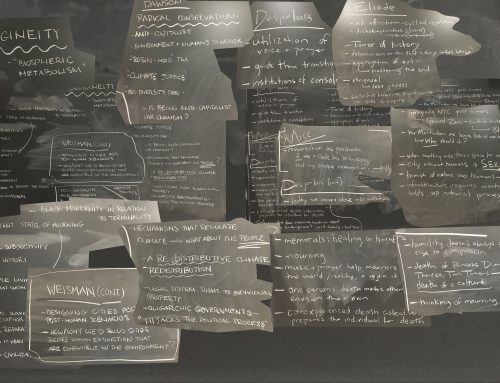The Ideology of Immortality: a Tool for Social Control
Research Group 1: Armando Dollero, Ousmane Sow and Oscar Fossum
In Professor Abou Farman’s essay “Terminality,” he discusses how “biomedicine has changed the horizon of death from a principally social and moral to a temporal one” (98). An individual’s distance from death is quantified by doctors, not as a tool of knowing how to prevent the death, but rather to reaffirm the remaining time an individual has to be alive. This seems to place a overvalue life at the expense of ignoring the realities that are part of dying. The normative argument here is that: it is good to live, and it is bad to die. Taken to the extreme, this would suggest a strong aversion to death, to the point of creating an ideology of immortality. Our group’s argument is that this is an ideological tool for social control. If the modern scientific ideal of “prognosis” sorts “the living not from the dead but from the dying,” then it consciously places a higher value on being alive, and thus imploring the individual to dissociate with “the dying” and to carry on with one’s daily work (Farman, 97).
Hart, Sainsbury and Short discuss historical versus modern takes on death in their essay “Whose dying? A sociological critique of the ‘good death’”. They describe two forms of death: the “tame death” and the “wild death”. Hart, Sainsbury and Short describe the “tame death” as an approach from a past time, where society took a ritualistic, ceremonial approach to death. On the other hand, Hart, Sainsbury and Short describe the “wild death” as a product of modern medicine’s ability to provide a “dying trajectory” to sick patients (67). In this case, the “wild death” is any death that falls outside of a medical prognosis, and therefore were perceived as “sudden and unexpected deaths [and] precipitated crises” (67). Our group found a distinct irony in the concept that an individual’s death process is in fact perceived to be less “autonomous” or controlled in the modern scientific society than it was in a more spiritual, religious-based society.
If a scientific medicine-based approach to death creates more sociological anxiety, does this not suggest a mis-handling of a process that we can see has been historically more calm? Our research aims to address ideals put forth by modern science which draw distinctions in treatment to two social groups “the living” and “the dying”. Because it is preferable to be among “the living,” in order to perpetuate a lifestyle of productivity and vitality, people will go to extreme lengths to avoid realizing the reality of death.
This concept that we have proposed as the “ideology of immortality” can be extrapolated to various social phenomena, including but not limited to racial and socioeconomic class segregation. For instance, Claudia Rankine highlights this concept in her essay “The Condition of Black Life Is One of Mourning” where she asserts that “when blacks become overwhelmed by our culture’s disorder and protest … the wrongheaded question that is asked is, What kind of savages are we? Rather than, What kind of country do we live in?” (4). In this context we can see that a certain inferior identity is thrust upon black culture and black people as the source of their own problems, instead of addressing society’s unfair treatment of the black community.
Rankine continues in her argument to detail the police shooting of Michael Brown, an unarmed black man in Ferguson, MO, and the subsequent handling (or mishandling) of his public death. Specifically, Michael Brown’s corpse was left on the street to be observed by community members. Rankine says that “by not moving Brown’s corpse for four hours after his shooting, the police made mourning his death part of what it meant to take in the details of his story” (5). Michael Brown’s death was the result of police brutality, for which there is no excuse. However, our group might argue that through the observation of the public murder of Michael Brown, and his corpse in the hours after, the Ferguson community was able to construct a narrative that would give logic to his death, and develop actionable solutions forward.
Finally, we would like to discuss the how the organization “Final Exit” and “The Order of the Good Death” offer a “tame death” response to the “wild death” created by modern science. Above, we have detailed how the tool of “prognosis” in modern healthcare separates the living from the dying as distinct social groups. In our discussion of Final Exit and The Order of the Good Death, we would like to detail current responses to death that reaffirm death as a natural process that is part of life, and thus bring “the dying” back into the social group of “the living”. The Order of the Good Death highlights this as one of their primary tenets on the homepage of their website, where community members “believe that by hiding death and dying behind closed doors we do more harm than good to our society” (http://www.orderofthegooddeath.com/death-positive). These organizations are made to empower “the dying” to control their individual experience of death. If we can continue to move towards this direction of empowering a societal openness to death, perhaps we can overcome the ideology of immortality, and re-establish that death is just another part of life. We argue that an adjusted approach to death gives more control to the dying individual, and perhaps alleviates society’s anxiety around the mysteriousness of death.

Recent Comments